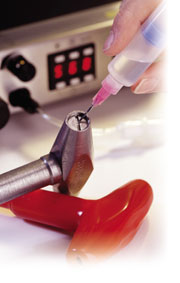Foolproof torque control at a reasonable price has made the company’s slip-type T-handle torque tools a worldwide standard among assembly workers, field technicians and other personnel who need to tighten bolts and other fasteners to specific torque values. As soon as the preset torque is reached, these precision tools automatically release and reset to prevent overtightening.
One of the final steps in the manufacturing process involves calibrating each tool by adjusting a screw on each side of the T handle. A small amount of cyanoacrylate or “super glue” is then applied to the screw to hold it in position. This seemingly simple task unexpectedly became a major issue when a new customer ordered a large batch of special-purpose tools.

New Process Poses New Dispensing Challenge
electrical modules, it wanted the shafts and handles encased in a thick, plastic coating to avoid the risk of injuries and short circuits, according to Bob D’Aiello, Seekonk Manufacturing’s quality assurance manager.After the tools were assembled and dip-coated, two small holes were drilled in the cured coating to permit access to the calibration screws. (The tools could not be calibrated prior to coating because the heat of the coating process could change the settings.) After adjusting the screws, the assembler applied cyanoacrylate by inserting the tip of a squeeze bottle through the hole.
On Seekonk’s standard, all-metal torque tools, the calibration screws are completely visible to the assemblers, but on the coated tools, the access holes limited their ability to see how much adhesive was applied.
Too Much Adhesive Causes Problem
Hundreds of the new coated wrenches had been in use for several months without a problem when one day the customer called D’Aiello to tell him a tool had failed to slip at the correct point and nearly stripped a bolt. When D’Aiello took the tool apart, he saw that too much cyanoacrylate had been applied to one of the calibration screws. The excess had wicked down into the tool’s internal mechanism and prevented it from releasing at the correct point.With the balance of the contract hinging on Seekonk’s corrective action, D’Aiello contacted EFD Inc., a manufacturer of precision dispensing equipment in nearby East Providence, R.I.
After discussing the details of the application with D’Aiello, EFD product specialist Tim Mandeville recommended the 1500XL-CA, a microprocessor-controlled fluid dispenser designed to apply consistent amounts of any type of cyanoacrylate.
The 1500XL-CA is a compact, tabletop unit that operates on compressed air and electricity and uses microprocessor circuitry to apply cyanoacrylate in accurate, repeatable amounts. The adhesive is contained in a disposable syringe reservoir connected to the dispenser console by lightweight, flexible tubing. The user just holds the syringe like a pen, places the tip in position and presses an electric foot pedal to apply a preset amount of adhesive.
To simplify setup, the 1500XL-CA features an easy-to-use “Teach” function that makes it simple to determine the correct amount of cyanoacrylate to use for a specific application. Deposit size can be fine-tuned if necessary by increasing or decreasing the length of the dispensing cycle in 0.1-, 0.01- or 0.001-second increments. Once the optimal cycle time for a particular application is known, it can be entered with the dispenser’s digital controls the next time that job is run.
Dispenser Eliminates Variability
The 1500XL-CA’s consistent cyanoacrylate deposits and ease of operation quickly provided the answer to Seekonk Manufacturing’s problem. Unlike the squeeze bottles, where the amount of cyanoacrylate applied depended on the skill and judgement of the individual, the EFD dispenser removed all variability from the process and ensured that the same amount was applied every time. All the user had to do was place the dispense tip at the edge of the screw head and tap the foot pedal.“After extensive testing of the
1500XL-CA, we knew we could be 99.9% sure the tools would not fail in the field,” D’Aiello says. “When we invited the customer to our plant and had its engineers try the dispenser for themselves, they were convinced, too.”
“Not one tool has locked up since we switched from the squeeze bottles to the EFD dispenser,” he concludes. “It helped us hold on to a key account and preserve a 60-year reputation.”
Additional information about the 1500XL-CA microprocessor-controlled fluid dispenser is available from EFD Inc., 977 Waterman Ave., East Providence, RI 02914; call 800-556-3484; fax 800-394-3585; e-mail info@efd-inc.com; or visit the Web site www.efd-inc.com. Or Circle No. 206
